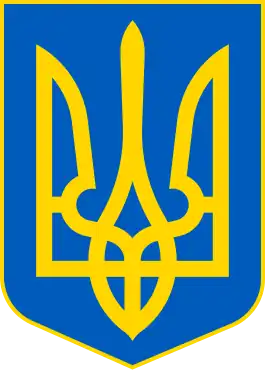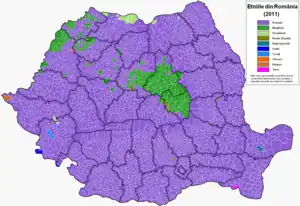 Distribution of Ukrainians in Romania (2002 census) | |
| Total population | |
|---|---|
| 45,835 (2021 census),[1] 51,703 (2011 census)[2] to 200,000 (unofficial estimate)[3] 109,871 Ukrainian-born refugees as of 2023[4] | |
| Regions with significant populations | |
| northern Romania, in areas close to the Ukrainian border | |
| Languages | |
| mainly Ukrainian and Romanian | |
| Religion | |
| Ukrainian Orthodox, Pentecostal, Greek-Catholic and very small numbers of Jews[5][6] and Muslims (mostly Tatars)[7] |
| Part of a series on |
| Ukrainians |
|---|
 |
| Culture |
| Languages and dialects |
| Religion |
| Sub-national groups |
| Closely-related peoples |
The Ukrainians (Ukrainian: Українці, Romanian: Ucraineni) are the third-largest ethnic minority in Romania. According to the 2011 Romanian census they number 51,703 people, making up 0.3% of the total population.[2] According to the 2021 Romanian census, there were 45,835 people who identified themselves officially as Ukrainians (0.24%), and 40,861 who declared that their language was Ukrainian.[8] According to the 2021 Romanian census, there were 834 people (0.004% of the population) who identified themselves officially as Rusyns, and 594 who declared that their language was Rusyn.[9] Ukrainians claim that the number is actually 250,000–300,000.[10] Ukrainians mainly live in northern Romania, in areas close to the Ukrainian border. Over 60% of all Romanian Ukrainians live in Maramureș County (31,234), where they make up 6.77% of the population. According to the U.S. Census Bureau, in 2015, there were 345 ethnic Ukrainians born in Romania who lived in the United States of America at that time.[11]
Sizable populations of Ukrainians are also found in Suceava County (5,698 people), Timiș County (5,953), Caraș-Severin County (2,600), Satu Mare County (1,397), Tulcea County (1,317), and Arad County (1,295). Ukrainians make up a majority in seven communes of Maramureș County (Bistra, Bocicoiu Mare, Poienile de sub Munte, Remeți, Repedea, Rona de Sus, and Ruscova) and three in Suceava County (Bălcăuți, Izvoarele Sucevei, and Ulma), as well as in Știuca, Timiș and Copăcele, Caraș-Severin. According to the 2002 census, 79% of Ukrainians were Eastern Orthodox, organized into the Ukrainian Orthodox Vicariate Sighetu Marmației; 10% Pentecostal; 2.8% Greek-Catholic, organized into the Ukrainian Greek-Catholic Vicariate Rădăuți; 2.1% Seventh-day Adventist; 1.2% Lipovan Orthodox and 2.9% stated they belonged to "another religion".[12]
A second group of Ukrainians in Romania live in the Dobruja region of the Danube Delta. These are descendants of Zaporozhian Cossacks who fled Russian rule in the 18th century. In 1830, they numbered 1,095 families.[13] Over the years they were joined by other peasants fleeing serfdom in the Russian Empire. In 1992, their descendants numbered four thousand people according to official Romanian statistics,[14] while the local community claims to number 20,000.[13] Known as Rusnaks,[15] they continue to pursue the traditional Cossack lifestyle of hunting and fishing.
Other Ukrainians came under the policy of Romanianization following the collapse of Austria-Hungary over the whole of Bukovina and relinquishment of Russian Empire over Bessarabia in 1918; the Romanianization policies brought the closure of the Ukrainian public schools (all such schools were closed until 1928) and the suppression of most of the Ukrainian (Ruthenian) cultural institutions. The very term "Ukrainians" was prohibited from the official usage and some Romanians of disputable Ukrainian ethnicity were rather called the "citizens of Romania who forgot their native language" and were forced to change their last names to Romanian-sounding ones.[16] Among those who were Romanianized were descendants of Romanians who were assimilated to Ukrainian society in the past. Among the latter were in turn the descendants of the Ukrainians who were Rumanized for centuries starting from the 14th century.[17][18]
During the interwar period, tens thousands of refugees from the USSR, mostly ethnic Romanians, Ukrainians, Russians, Jews, Tatars and others (many of them coming from Soviet Ukraine) migrated to Romania.[19][20][21]
As an officially recognised ethnic minority, Ukrainians have one seat reserved in the Romanian Chamber of Deputies. Ștefan Tcaciuc held the seat from 1990 until his 2005 death, when he was replaced by Ștefan Buciuta. The Union of Ukrainians of Romania obtained 5,457 votes (0.09%) in the Chamber of Deputies election of 2020.[22]
After 1989, a significant number of Ukrainian citizens (including ethnic Romanians/Moldovans from Ukraine) started immigrating to Romania (students, migrant workers, businesspeople, refugees). As of 2019, there are at least 18,000 Ukrainian-born people living in Romania, most of them living in large cities, such as Bucharest, Cluj-Napoca, or Timișoara.[23]
Around 600,000 Ukrainians have fled to Romania since the start of the Russo-Ukrainian War.[24]
Notable people
- Emil Bodnăraș - politician and army officer
- Ioan Dzițac - professor of mathematics and computer science
- Dmytro Hnatyuk - baritone opera singer
- Vasile Hutopilă - painter
- Mykhailo Mykhailyuk Ilkovych - poet, literary critic
- Simion Ismailciuc - sprint canoeist, won the Summer Olympics, two World Championships and three European Championships
- Olha Kobylianska - writer and feminist
- Anna Lesko - singer
- Ivan Pavlovich Maksimovich - Colonel of the UGA
- Miroslava Șandru - ethnographer and folklorist
- Antin Varivoda - Colonel of the UGA
- Nicodemus (Rusnak) - Ukrainian Orthodox metropolitan bishop of Kharkiv and Bohodukhiv
See also
References
- ↑ https://web.archive.org/web/20221230125029/https://insse.ro/cms/sites/default/files/com_presa/com_pdf/cp-date-provizorii-rpl_2.pdf, p. 11
- 1 2 (in Romanian) "Comunicat de presă privind rezultatele provizorii ale Recensământului Populației și Locuințelor – 2011", at the 2011 census site; accessed February 2, 2012.
- ↑ "Українська діаспора в Румунії".
- ↑ "War in Ukraine: Which European countries host the most refugees?". 20 September 2023.
- ↑ ""Mii de israelieni şi evrei ucraineni", evacuaţi din Ucraina prin România".
- ↑ ""Acest război e o catastrofă pentru Europa" – DW – 19.08.2022". Deutsche Welle.
- ↑ "Oficiali români și turci și refugiați musulmani din Ucraina, invitații Uniunii Democrate Turce din România la iftar". May 2022.
- ↑ "Comunicat de presă Primele date provizorii pentru Recensământul Populației și Locuințelor, runda 2021", at https://web.archive.org/web/20221230125029/https://insse.ro/cms/sites/default/files/com_presa/com_pdf/cp-date-provizorii-rpl_2.pdf , p. 11 (on ethnicity) and p. 12 (on language).
- ↑ https://web.archive.org/web/20221230125029/https://insse.ro/cms/sites/default/files/com_presa/com_pdf/cp-date-provizorii-rpl_2.pdf, p. 13-14.
- ↑ "The Ukrainians: Engaging the 'Eastern Diaspora'". By Andrew Wilson. (1999). In Charles King, Neil Melvin (Eds.) Nations Abroad. Wesview Press, pp. 103-132. ISBN 0-8133-3738-0
- ↑ "Explore Census Data".
- ↑ (in Romanian) Populația după etnie și religie, pe medii, at the 2002 Census official site; accessed January 4, 2010.
- 1 2 Union of Ukrainians in Romania website Archived 2008-12-30 at the Wayback Machine
- ↑ Calculated from statistics for the counties of Tulcea and Constanța from "Populația după etnie la recensămintele din perioada 1930–2002, pe judete" (PDF) (in Romanian). Guvernul României — Agenția Națională pentru Romi. pp. 5–6, 13–14. Retrieved 2007-05-02.
- ↑ "Dobrudja". Encyclopedia of Ukraine. Retrieved December 21, 2006.
- ↑ Oleksandr Derhachov (editor), "Ukrainian Statehood in the Twentieth Century: Historical and Political Analysis", Chapter: "Ukraine in Romanian concepts of the foreign policy", 1996, Kiev ISBN 966-543-040-8
- ↑ "Bukovyna". Internet Encyclopedia of Ukraine. Archived from the original on 13 May 2021. Retrieved 22 June 2021.
- ↑ Ivan Katchanovski; Zenon E. Kohut; Bohdan Y. Nebesio; Myroslav Yurkevich (2013). Historical Dictionary of Ukraine. Scarecrow Press. pp. 64–66. ISBN 978-0-8108-7847-1.
- ↑ "Refugiaţi, emigranţi din URSS către România interbelică".
- ↑ "Cum a gestionat România criza refugiaţilor din perioada interbelică. 100.000 de evrei, ruşi şi ucraineni s-au refugiat aici la începutul anilor '20". 29 September 2015.
- ↑ "Refugiaţii evrei, din Ucraina sovietică în Basarabia română".
- ↑ https://parlamentare2020.bec.ro/wp-content/uploads/2020/12/com_1423.pdf
- ↑ "Immigrant and emigrant populations country origin and destination". Migration Policy. 10 February 2014. Retrieved 26 March 2021.
- ↑ "The network in Romania to help Ukrainian refugees". NPR.org. Retrieved 2022-04-26.

